Comprehensive Report: Nestle's Supply Chain Management Strategies
VerifiedAdded on 2020/03/16
|16
|3620
|3235
Report
AI Summary
This report provides a comprehensive analysis of Nestle's supply chain management, examining its core components, strategies, and the significant impact of the palm oil crisis. It delves into the roles of supply chain in Nestle’s operations, outlining the company's goals, particularly in relation to customer service and profitability. The report explores Nestle's supply chain strategy, including its implementation and the crucial roles of major suppliers like Sinar Mars and Wilmar, as well as their responses to environmental concerns. It highlights the impact of supply chain decisions on Nestle's operations, including the shift towards sustainable sourcing and the challenges faced in ensuring ethical practices. The report concludes with an overview of Nestle's efforts to improve transparency, traceability, and sustainability within its supply chain, emphasizing the importance of stakeholder engagement and adherence to responsible sourcing guidelines. Furthermore, the report showcases the company's commitment to ethical practices by addressing the environmental and social issues associated with its supply chain.
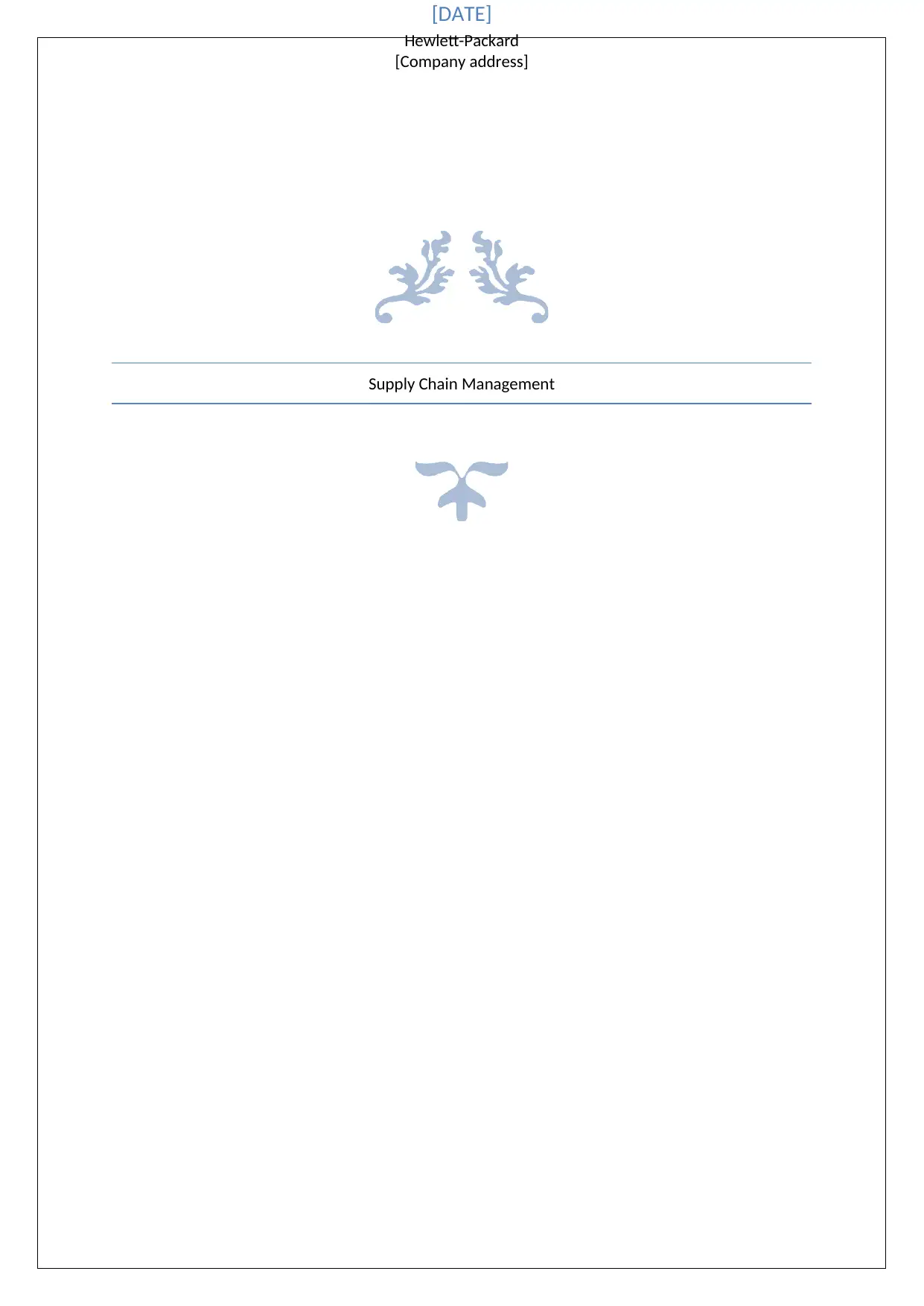
Supply Chain Management
[DATE]
Hewlett-Packard
[Company address]
[DATE]
Hewlett-Packard
[Company address]
Paraphrase This Document
Need a fresh take? Get an instant paraphrase of this document with our AI Paraphraser
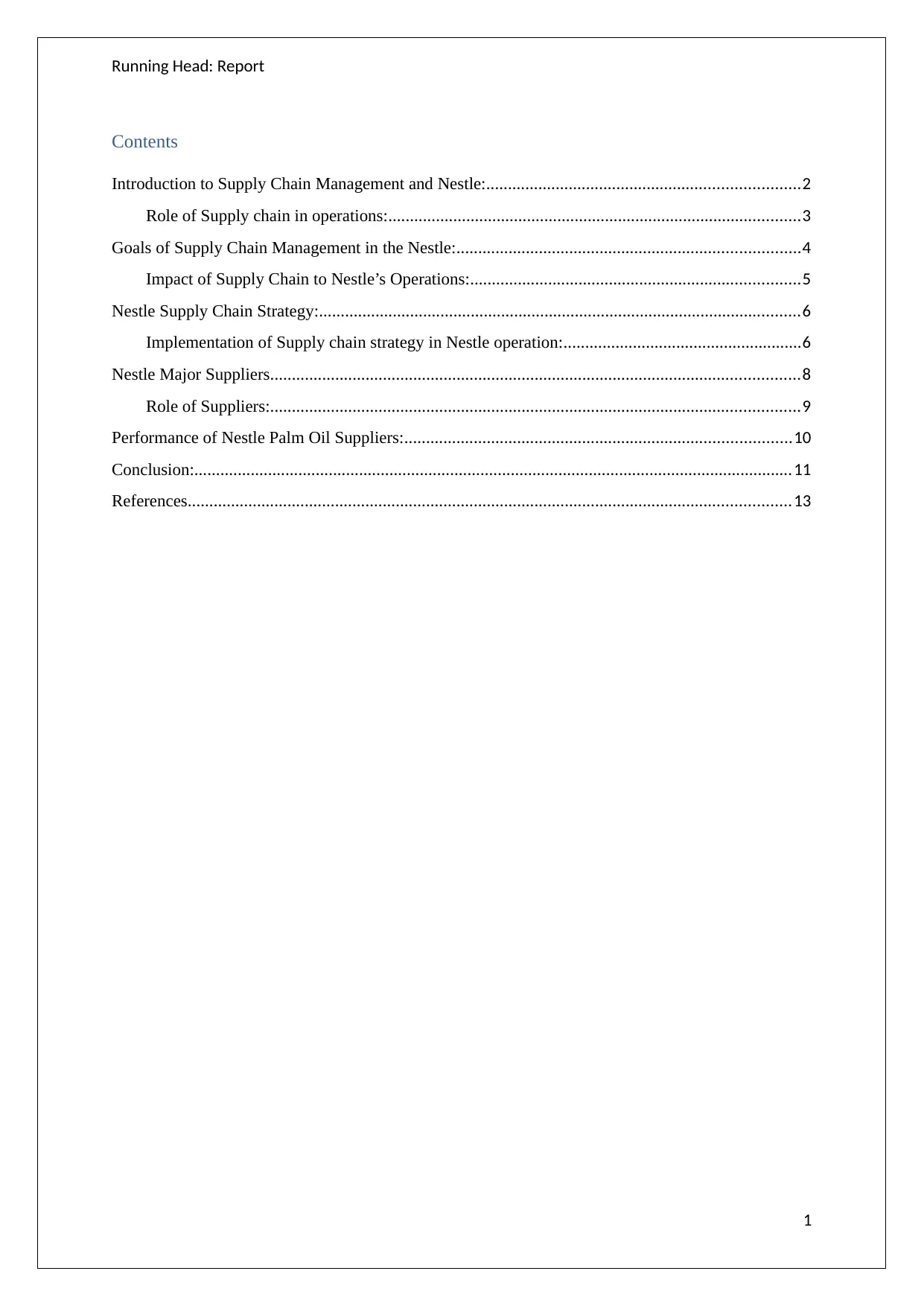
Running Head: Report
Contents
Introduction to Supply Chain Management and Nestle:........................................................................2
Role of Supply chain in operations:...............................................................................................3
Goals of Supply Chain Management in the Nestle:...............................................................................4
Impact of Supply Chain to Nestle’s Operations:............................................................................5
Nestle Supply Chain Strategy:...............................................................................................................6
Implementation of Supply chain strategy in Nestle operation:.......................................................6
Nestle Major Suppliers..........................................................................................................................8
Role of Suppliers:..........................................................................................................................9
Performance of Nestle Palm Oil Suppliers:.........................................................................................10
Conclusion:..........................................................................................................................................11
References...........................................................................................................................................13
1
Contents
Introduction to Supply Chain Management and Nestle:........................................................................2
Role of Supply chain in operations:...............................................................................................3
Goals of Supply Chain Management in the Nestle:...............................................................................4
Impact of Supply Chain to Nestle’s Operations:............................................................................5
Nestle Supply Chain Strategy:...............................................................................................................6
Implementation of Supply chain strategy in Nestle operation:.......................................................6
Nestle Major Suppliers..........................................................................................................................8
Role of Suppliers:..........................................................................................................................9
Performance of Nestle Palm Oil Suppliers:.........................................................................................10
Conclusion:..........................................................................................................................................11
References...........................................................................................................................................13
1
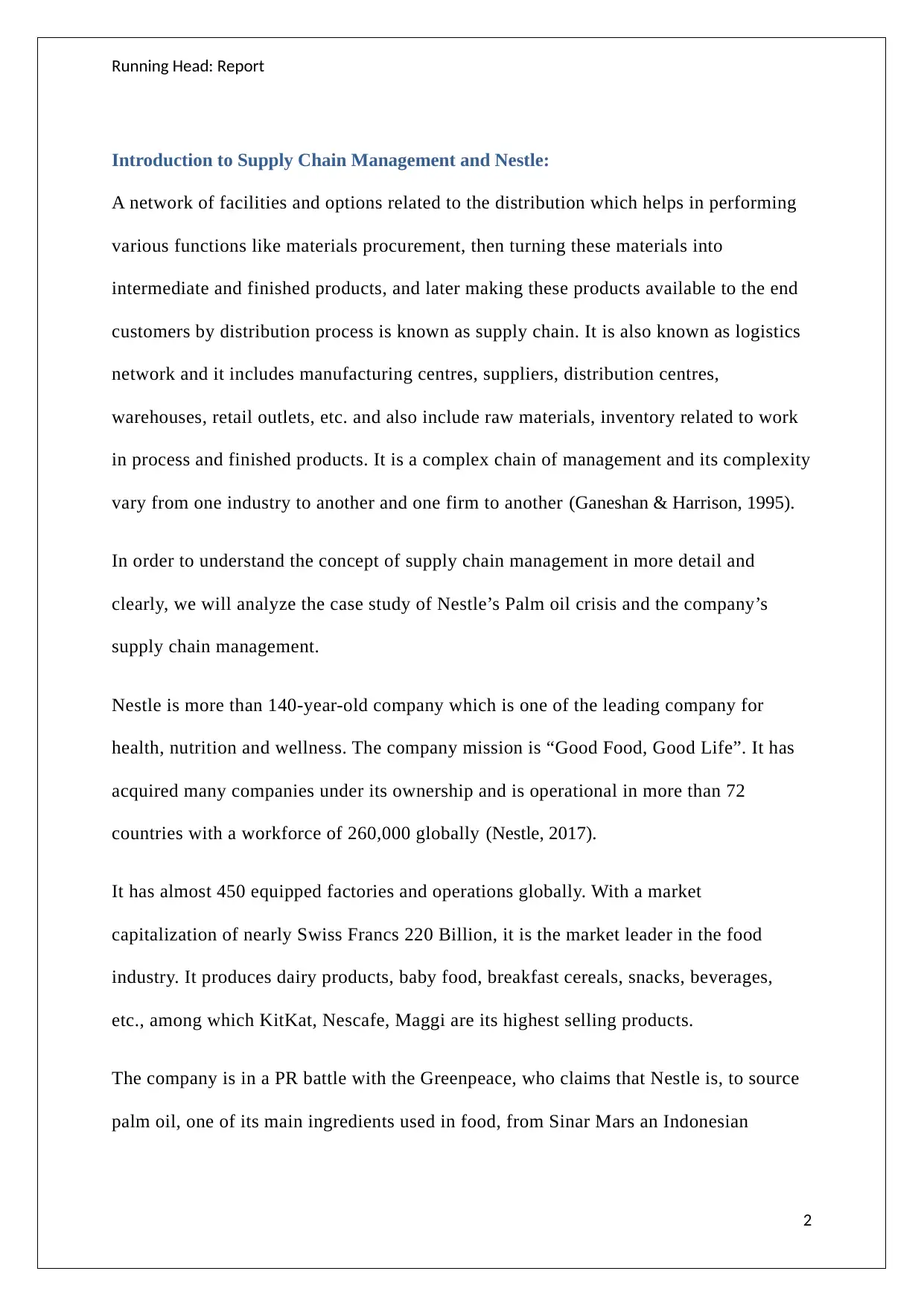
Running Head: Report
Introduction to Supply Chain Management and Nestle:
A network of facilities and options related to the distribution which helps in performing
various functions like materials procurement, then turning these materials into
intermediate and finished products, and later making these products available to the end
customers by distribution process is known as supply chain. It is also known as logistics
network and it includes manufacturing centres, suppliers, distribution centres,
warehouses, retail outlets, etc. and also include raw materials, inventory related to work
in process and finished products. It is a complex chain of management and its complexity
vary from one industry to another and one firm to another (Ganeshan & Harrison, 1995).
In order to understand the concept of supply chain management in more detail and
clearly, we will analyze the case study of Nestle’s Palm oil crisis and the company’s
supply chain management.
Nestle is more than 140-year-old company which is one of the leading company for
health, nutrition and wellness. The company mission is “Good Food, Good Life”. It has
acquired many companies under its ownership and is operational in more than 72
countries with a workforce of 260,000 globally (Nestle, 2017).
It has almost 450 equipped factories and operations globally. With a market
capitalization of nearly Swiss Francs 220 Billion, it is the market leader in the food
industry. It produces dairy products, baby food, breakfast cereals, snacks, beverages,
etc., among which KitKat, Nescafe, Maggi are its highest selling products.
The company is in a PR battle with the Greenpeace, who claims that Nestle is, to source
palm oil, one of its main ingredients used in food, from Sinar Mars an Indonesian
2
Introduction to Supply Chain Management and Nestle:
A network of facilities and options related to the distribution which helps in performing
various functions like materials procurement, then turning these materials into
intermediate and finished products, and later making these products available to the end
customers by distribution process is known as supply chain. It is also known as logistics
network and it includes manufacturing centres, suppliers, distribution centres,
warehouses, retail outlets, etc. and also include raw materials, inventory related to work
in process and finished products. It is a complex chain of management and its complexity
vary from one industry to another and one firm to another (Ganeshan & Harrison, 1995).
In order to understand the concept of supply chain management in more detail and
clearly, we will analyze the case study of Nestle’s Palm oil crisis and the company’s
supply chain management.
Nestle is more than 140-year-old company which is one of the leading company for
health, nutrition and wellness. The company mission is “Good Food, Good Life”. It has
acquired many companies under its ownership and is operational in more than 72
countries with a workforce of 260,000 globally (Nestle, 2017).
It has almost 450 equipped factories and operations globally. With a market
capitalization of nearly Swiss Francs 220 Billion, it is the market leader in the food
industry. It produces dairy products, baby food, breakfast cereals, snacks, beverages,
etc., among which KitKat, Nescafe, Maggi are its highest selling products.
The company is in a PR battle with the Greenpeace, who claims that Nestle is, to source
palm oil, one of its main ingredients used in food, from Sinar Mars an Indonesian
2
⊘ This is a preview!⊘
Do you want full access?
Subscribe today to unlock all pages.

Trusted by 1+ million students worldwide

Running Head: Report
company, who were its main supplier. Sinar Mars temperature of peatland clearance,
illegal deforestation and illegal child and human labor.
While other companies suspended their contract with the Sinar Mars, but Nestle was
still using its supplier's services. The company said that supply chain full review will
take a year or so. Nestle is trying to improvise its palm oil supply chain transparency and
reporting (CSCMP, 2017).
Role of Supply chain in operations:
Supply chain management forms an integral part of the day to day operations of a
company as well as it is very essential to the company’s success and providing
satisfaction to the customers.
It is like the backbone of the company wherein it manages issues which are very critical
from an organization point of view and are directly or indirectly related to the corporate
strategy, like its rapid growth, expanding globally and issues related to the environment.
Few of its 140-year-old roles are making goods available to the users, helps in efficient
manufacturing strategy etc.
At Nestle, the supply chain management has a critical role where it makes sure that only
quality products are reached to its customers and consumers. The company collaborates
with its team and forecast the demand which is then provided to the suppliers, so that
they can provide materials. Inventory levels are balanced with the operations so that
exact supply of products can be done. The supply chain of Nestle, after the production, is
responsible for its safe storage and transportation to customers and consumers demands
on time. Nestle is an organization which is agile and aligned kind of organization, which
3
company, who were its main supplier. Sinar Mars temperature of peatland clearance,
illegal deforestation and illegal child and human labor.
While other companies suspended their contract with the Sinar Mars, but Nestle was
still using its supplier's services. The company said that supply chain full review will
take a year or so. Nestle is trying to improvise its palm oil supply chain transparency and
reporting (CSCMP, 2017).
Role of Supply chain in operations:
Supply chain management forms an integral part of the day to day operations of a
company as well as it is very essential to the company’s success and providing
satisfaction to the customers.
It is like the backbone of the company wherein it manages issues which are very critical
from an organization point of view and are directly or indirectly related to the corporate
strategy, like its rapid growth, expanding globally and issues related to the environment.
Few of its 140-year-old roles are making goods available to the users, helps in efficient
manufacturing strategy etc.
At Nestle, the supply chain management has a critical role where it makes sure that only
quality products are reached to its customers and consumers. The company collaborates
with its team and forecast the demand which is then provided to the suppliers, so that
they can provide materials. Inventory levels are balanced with the operations so that
exact supply of products can be done. The supply chain of Nestle, after the production, is
responsible for its safe storage and transportation to customers and consumers demands
on time. Nestle is an organization which is agile and aligned kind of organization, which
3
Paraphrase This Document
Need a fresh take? Get an instant paraphrase of this document with our AI Paraphraser
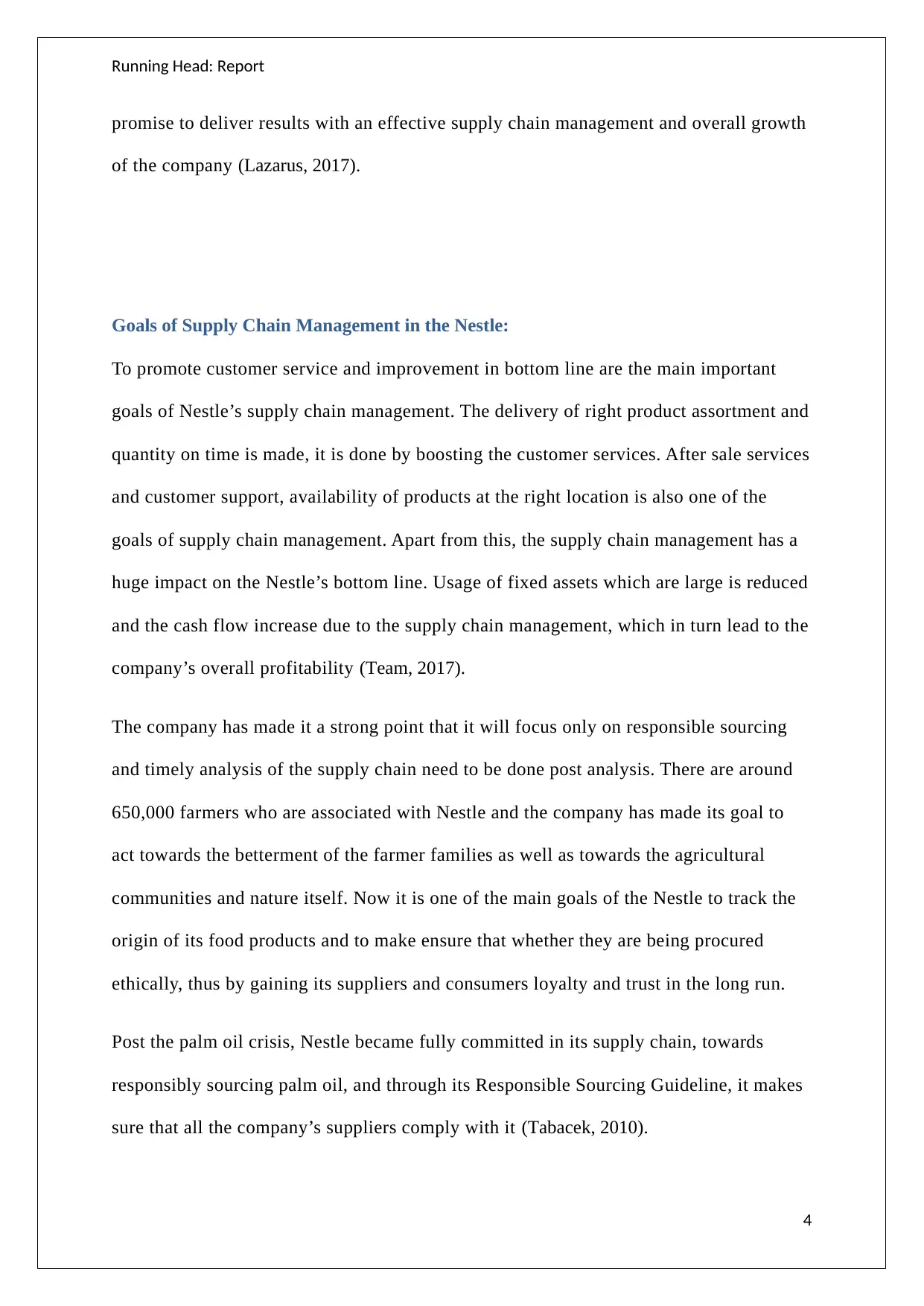
Running Head: Report
promise to deliver results with an effective supply chain management and overall growth
of the company (Lazarus, 2017).
Goals of Supply Chain Management in the Nestle:
To promote customer service and improvement in bottom line are the main important
goals of Nestle’s supply chain management. The delivery of right product assortment and
quantity on time is made, it is done by boosting the customer services. After sale services
and customer support, availability of products at the right location is also one of the
goals of supply chain management. Apart from this, the supply chain management has a
huge impact on the Nestle’s bottom line. Usage of fixed assets which are large is reduced
and the cash flow increase due to the supply chain management, which in turn lead to the
company’s overall profitability (Team, 2017).
The company has made it a strong point that it will focus only on responsible sourcing
and timely analysis of the supply chain need to be done post analysis. There are around
650,000 farmers who are associated with Nestle and the company has made its goal to
act towards the betterment of the farmer families as well as towards the agricultural
communities and nature itself. Now it is one of the main goals of the Nestle to track the
origin of its food products and to make ensure that whether they are being procured
ethically, thus by gaining its suppliers and consumers loyalty and trust in the long run.
Post the palm oil crisis, Nestle became fully committed in its supply chain, towards
responsibly sourcing palm oil, and through its Responsible Sourcing Guideline, it makes
sure that all the company’s suppliers comply with it (Tabacek, 2010).
4
promise to deliver results with an effective supply chain management and overall growth
of the company (Lazarus, 2017).
Goals of Supply Chain Management in the Nestle:
To promote customer service and improvement in bottom line are the main important
goals of Nestle’s supply chain management. The delivery of right product assortment and
quantity on time is made, it is done by boosting the customer services. After sale services
and customer support, availability of products at the right location is also one of the
goals of supply chain management. Apart from this, the supply chain management has a
huge impact on the Nestle’s bottom line. Usage of fixed assets which are large is reduced
and the cash flow increase due to the supply chain management, which in turn lead to the
company’s overall profitability (Team, 2017).
The company has made it a strong point that it will focus only on responsible sourcing
and timely analysis of the supply chain need to be done post analysis. There are around
650,000 farmers who are associated with Nestle and the company has made its goal to
act towards the betterment of the farmer families as well as towards the agricultural
communities and nature itself. Now it is one of the main goals of the Nestle to track the
origin of its food products and to make ensure that whether they are being procured
ethically, thus by gaining its suppliers and consumers loyalty and trust in the long run.
Post the palm oil crisis, Nestle became fully committed in its supply chain, towards
responsibly sourcing palm oil, and through its Responsible Sourcing Guideline, it makes
sure that all the company’s suppliers comply with it (Tabacek, 2010).
4
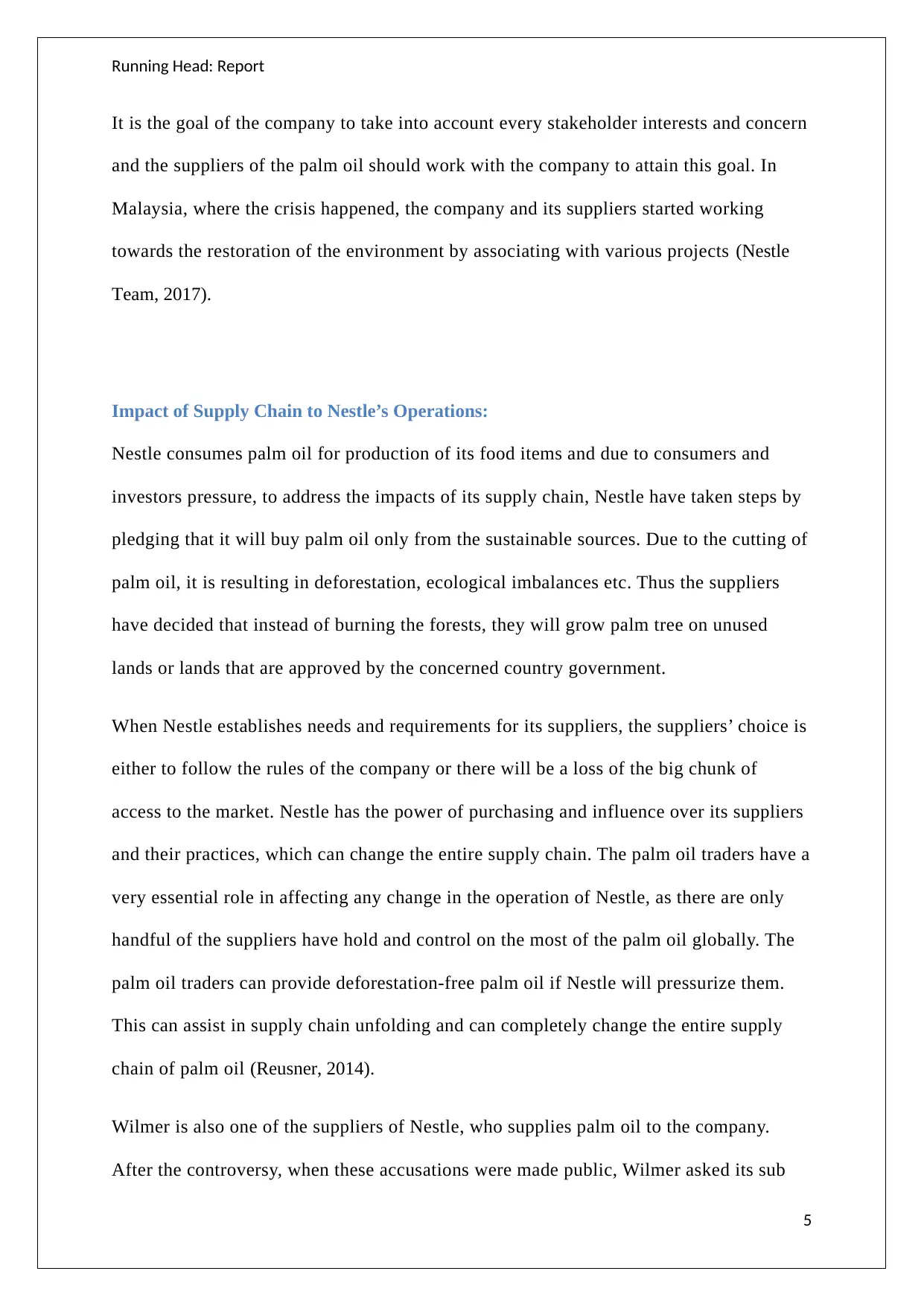
Running Head: Report
It is the goal of the company to take into account every stakeholder interests and concern
and the suppliers of the palm oil should work with the company to attain this goal. In
Malaysia, where the crisis happened, the company and its suppliers started working
towards the restoration of the environment by associating with various projects (Nestle
Team, 2017).
Impact of Supply Chain to Nestle’s Operations:
Nestle consumes palm oil for production of its food items and due to consumers and
investors pressure, to address the impacts of its supply chain, Nestle have taken steps by
pledging that it will buy palm oil only from the sustainable sources. Due to the cutting of
palm oil, it is resulting in deforestation, ecological imbalances etc. Thus the suppliers
have decided that instead of burning the forests, they will grow palm tree on unused
lands or lands that are approved by the concerned country government.
When Nestle establishes needs and requirements for its suppliers, the suppliers’ choice is
either to follow the rules of the company or there will be a loss of the big chunk of
access to the market. Nestle has the power of purchasing and influence over its suppliers
and their practices, which can change the entire supply chain. The palm oil traders have a
very essential role in affecting any change in the operation of Nestle, as there are only
handful of the suppliers have hold and control on the most of the palm oil globally. The
palm oil traders can provide deforestation-free palm oil if Nestle will pressurize them.
This can assist in supply chain unfolding and can completely change the entire supply
chain of palm oil (Reusner, 2014).
Wilmer is also one of the suppliers of Nestle, who supplies palm oil to the company.
After the controversy, when these accusations were made public, Wilmer asked its sub
5
It is the goal of the company to take into account every stakeholder interests and concern
and the suppliers of the palm oil should work with the company to attain this goal. In
Malaysia, where the crisis happened, the company and its suppliers started working
towards the restoration of the environment by associating with various projects (Nestle
Team, 2017).
Impact of Supply Chain to Nestle’s Operations:
Nestle consumes palm oil for production of its food items and due to consumers and
investors pressure, to address the impacts of its supply chain, Nestle have taken steps by
pledging that it will buy palm oil only from the sustainable sources. Due to the cutting of
palm oil, it is resulting in deforestation, ecological imbalances etc. Thus the suppliers
have decided that instead of burning the forests, they will grow palm tree on unused
lands or lands that are approved by the concerned country government.
When Nestle establishes needs and requirements for its suppliers, the suppliers’ choice is
either to follow the rules of the company or there will be a loss of the big chunk of
access to the market. Nestle has the power of purchasing and influence over its suppliers
and their practices, which can change the entire supply chain. The palm oil traders have a
very essential role in affecting any change in the operation of Nestle, as there are only
handful of the suppliers have hold and control on the most of the palm oil globally. The
palm oil traders can provide deforestation-free palm oil if Nestle will pressurize them.
This can assist in supply chain unfolding and can completely change the entire supply
chain of palm oil (Reusner, 2014).
Wilmer is also one of the suppliers of Nestle, who supplies palm oil to the company.
After the controversy, when these accusations were made public, Wilmer asked its sub
5
⊘ This is a preview!⊘
Do you want full access?
Subscribe today to unlock all pages.

Trusted by 1+ million students worldwide
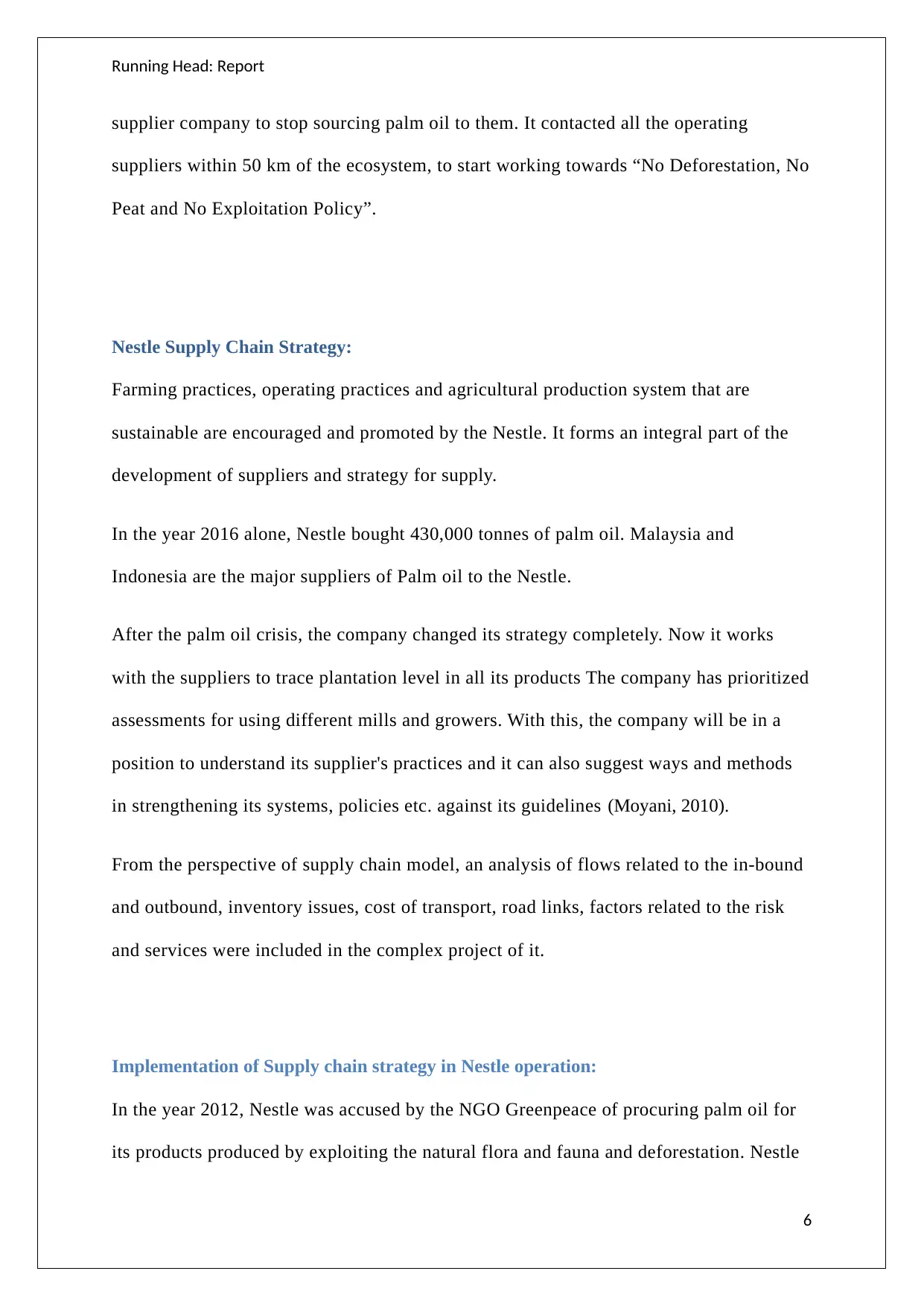
Running Head: Report
supplier company to stop sourcing palm oil to them. It contacted all the operating
suppliers within 50 km of the ecosystem, to start working towards “No Deforestation, No
Peat and No Exploitation Policy”.
Nestle Supply Chain Strategy:
Farming practices, operating practices and agricultural production system that are
sustainable are encouraged and promoted by the Nestle. It forms an integral part of the
development of suppliers and strategy for supply.
In the year 2016 alone, Nestle bought 430,000 tonnes of palm oil. Malaysia and
Indonesia are the major suppliers of Palm oil to the Nestle.
After the palm oil crisis, the company changed its strategy completely. Now it works
with the suppliers to trace plantation level in all its products The company has prioritized
assessments for using different mills and growers. With this, the company will be in a
position to understand its supplier's practices and it can also suggest ways and methods
in strengthening its systems, policies etc. against its guidelines (Moyani, 2010).
From the perspective of supply chain model, an analysis of flows related to the in-bound
and outbound, inventory issues, cost of transport, road links, factors related to the risk
and services were included in the complex project of it.
Implementation of Supply chain strategy in Nestle operation:
In the year 2012, Nestle was accused by the NGO Greenpeace of procuring palm oil for
its products produced by exploiting the natural flora and fauna and deforestation. Nestle
6
supplier company to stop sourcing palm oil to them. It contacted all the operating
suppliers within 50 km of the ecosystem, to start working towards “No Deforestation, No
Peat and No Exploitation Policy”.
Nestle Supply Chain Strategy:
Farming practices, operating practices and agricultural production system that are
sustainable are encouraged and promoted by the Nestle. It forms an integral part of the
development of suppliers and strategy for supply.
In the year 2016 alone, Nestle bought 430,000 tonnes of palm oil. Malaysia and
Indonesia are the major suppliers of Palm oil to the Nestle.
After the palm oil crisis, the company changed its strategy completely. Now it works
with the suppliers to trace plantation level in all its products The company has prioritized
assessments for using different mills and growers. With this, the company will be in a
position to understand its supplier's practices and it can also suggest ways and methods
in strengthening its systems, policies etc. against its guidelines (Moyani, 2010).
From the perspective of supply chain model, an analysis of flows related to the in-bound
and outbound, inventory issues, cost of transport, road links, factors related to the risk
and services were included in the complex project of it.
Implementation of Supply chain strategy in Nestle operation:
In the year 2012, Nestle was accused by the NGO Greenpeace of procuring palm oil for
its products produced by exploiting the natural flora and fauna and deforestation. Nestle
6
Paraphrase This Document
Need a fresh take? Get an instant paraphrase of this document with our AI Paraphraser
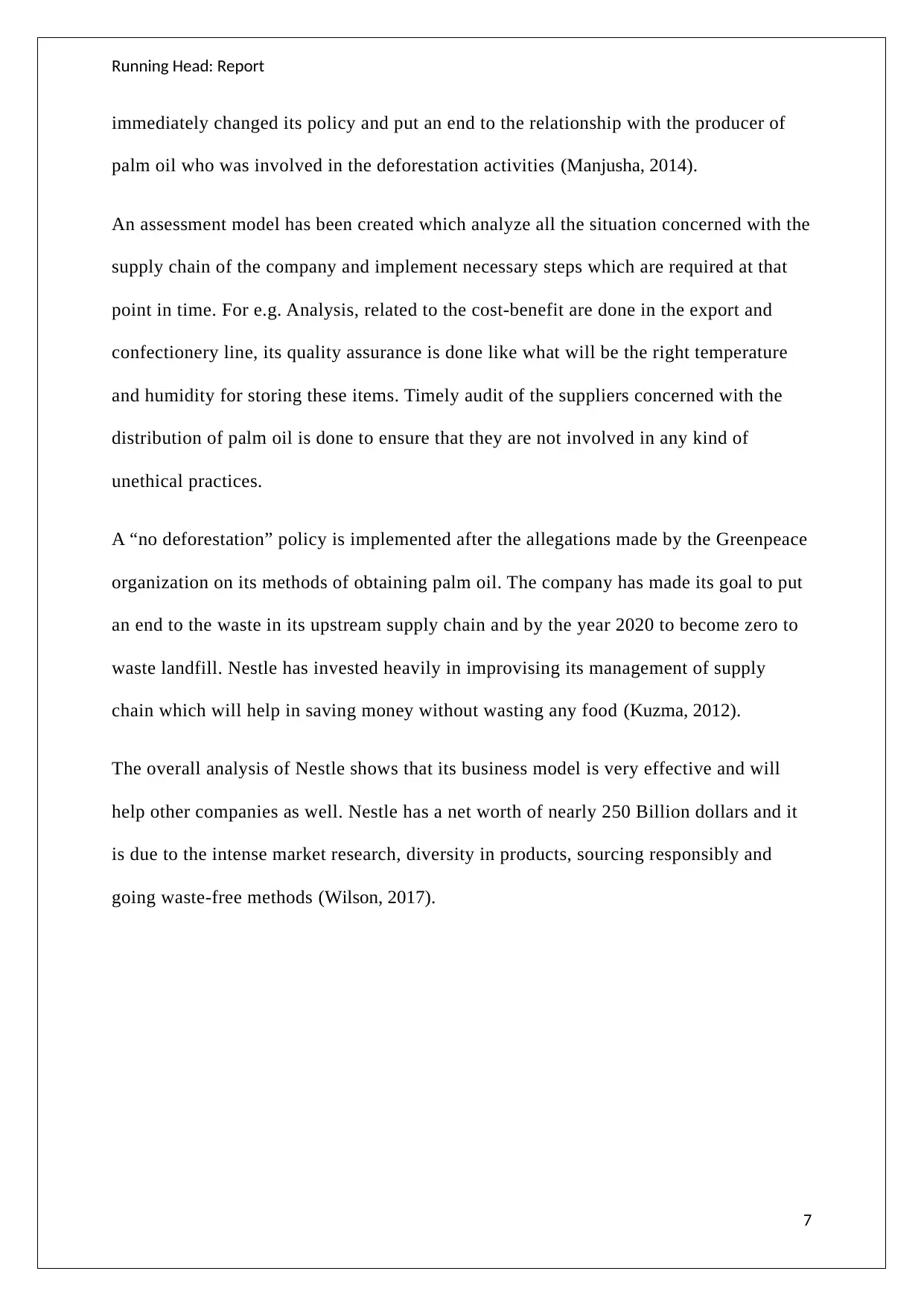
Running Head: Report
immediately changed its policy and put an end to the relationship with the producer of
palm oil who was involved in the deforestation activities (Manjusha, 2014).
An assessment model has been created which analyze all the situation concerned with the
supply chain of the company and implement necessary steps which are required at that
point in time. For e.g. Analysis, related to the cost-benefit are done in the export and
confectionery line, its quality assurance is done like what will be the right temperature
and humidity for storing these items. Timely audit of the suppliers concerned with the
distribution of palm oil is done to ensure that they are not involved in any kind of
unethical practices.
A “no deforestation” policy is implemented after the allegations made by the Greenpeace
organization on its methods of obtaining palm oil. The company has made its goal to put
an end to the waste in its upstream supply chain and by the year 2020 to become zero to
waste landfill. Nestle has invested heavily in improvising its management of supply
chain which will help in saving money without wasting any food (Kuzma, 2012).
The overall analysis of Nestle shows that its business model is very effective and will
help other companies as well. Nestle has a net worth of nearly 250 Billion dollars and it
is due to the intense market research, diversity in products, sourcing responsibly and
going waste-free methods (Wilson, 2017).
7
immediately changed its policy and put an end to the relationship with the producer of
palm oil who was involved in the deforestation activities (Manjusha, 2014).
An assessment model has been created which analyze all the situation concerned with the
supply chain of the company and implement necessary steps which are required at that
point in time. For e.g. Analysis, related to the cost-benefit are done in the export and
confectionery line, its quality assurance is done like what will be the right temperature
and humidity for storing these items. Timely audit of the suppliers concerned with the
distribution of palm oil is done to ensure that they are not involved in any kind of
unethical practices.
A “no deforestation” policy is implemented after the allegations made by the Greenpeace
organization on its methods of obtaining palm oil. The company has made its goal to put
an end to the waste in its upstream supply chain and by the year 2020 to become zero to
waste landfill. Nestle has invested heavily in improvising its management of supply
chain which will help in saving money without wasting any food (Kuzma, 2012).
The overall analysis of Nestle shows that its business model is very effective and will
help other companies as well. Nestle has a net worth of nearly 250 Billion dollars and it
is due to the intense market research, diversity in products, sourcing responsibly and
going waste-free methods (Wilson, 2017).
7
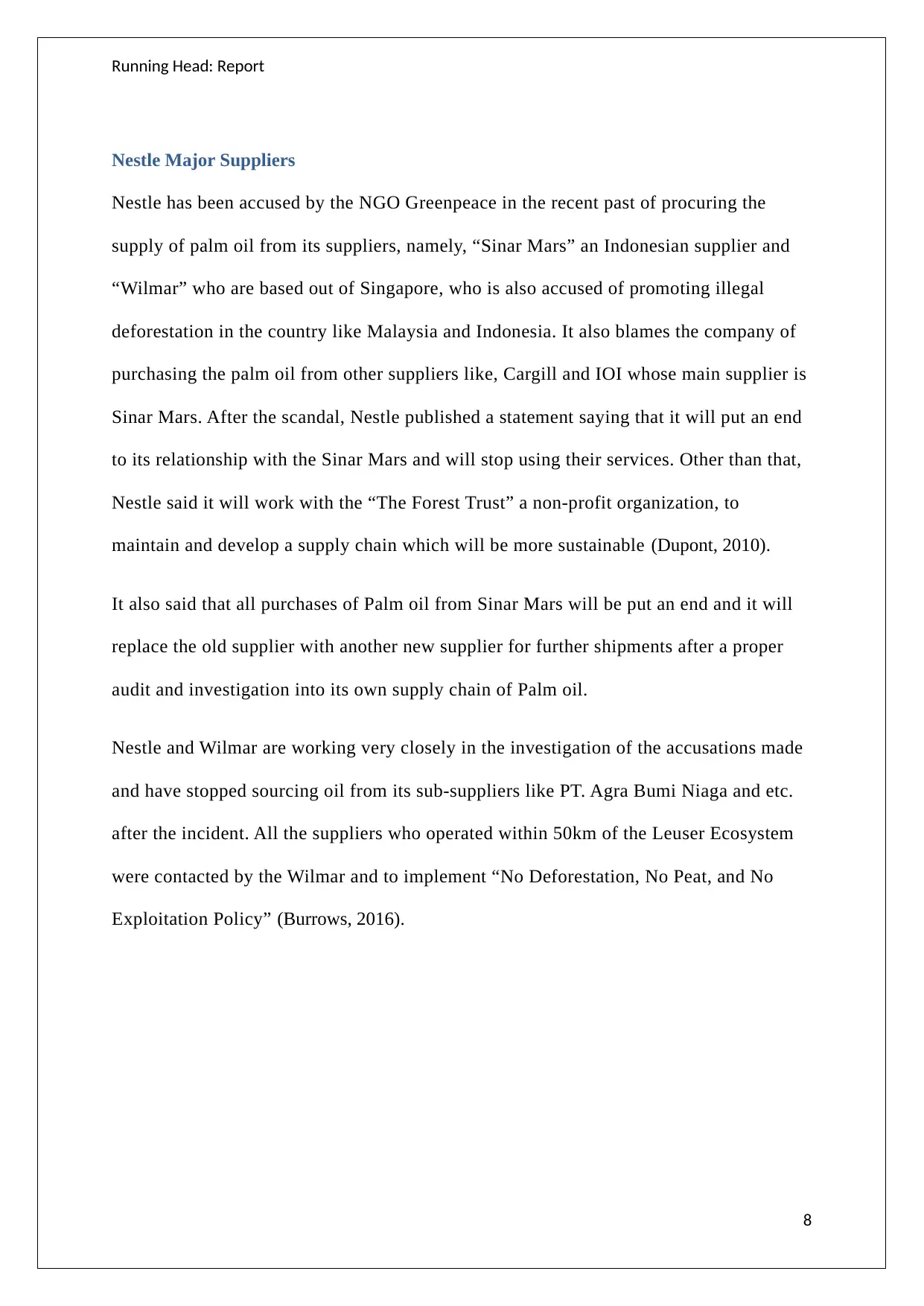
Running Head: Report
Nestle Major Suppliers
Nestle has been accused by the NGO Greenpeace in the recent past of procuring the
supply of palm oil from its suppliers, namely, “Sinar Mars” an Indonesian supplier and
“Wilmar” who are based out of Singapore, who is also accused of promoting illegal
deforestation in the country like Malaysia and Indonesia. It also blames the company of
purchasing the palm oil from other suppliers like, Cargill and IOI whose main supplier is
Sinar Mars. After the scandal, Nestle published a statement saying that it will put an end
to its relationship with the Sinar Mars and will stop using their services. Other than that,
Nestle said it will work with the “The Forest Trust” a non-profit organization, to
maintain and develop a supply chain which will be more sustainable (Dupont, 2010).
It also said that all purchases of Palm oil from Sinar Mars will be put an end and it will
replace the old supplier with another new supplier for further shipments after a proper
audit and investigation into its own supply chain of Palm oil.
Nestle and Wilmar are working very closely in the investigation of the accusations made
and have stopped sourcing oil from its sub-suppliers like PT. Agra Bumi Niaga and etc.
after the incident. All the suppliers who operated within 50km of the Leuser Ecosystem
were contacted by the Wilmar and to implement “No Deforestation, No Peat, and No
Exploitation Policy” (Burrows, 2016).
8
Nestle Major Suppliers
Nestle has been accused by the NGO Greenpeace in the recent past of procuring the
supply of palm oil from its suppliers, namely, “Sinar Mars” an Indonesian supplier and
“Wilmar” who are based out of Singapore, who is also accused of promoting illegal
deforestation in the country like Malaysia and Indonesia. It also blames the company of
purchasing the palm oil from other suppliers like, Cargill and IOI whose main supplier is
Sinar Mars. After the scandal, Nestle published a statement saying that it will put an end
to its relationship with the Sinar Mars and will stop using their services. Other than that,
Nestle said it will work with the “The Forest Trust” a non-profit organization, to
maintain and develop a supply chain which will be more sustainable (Dupont, 2010).
It also said that all purchases of Palm oil from Sinar Mars will be put an end and it will
replace the old supplier with another new supplier for further shipments after a proper
audit and investigation into its own supply chain of Palm oil.
Nestle and Wilmar are working very closely in the investigation of the accusations made
and have stopped sourcing oil from its sub-suppliers like PT. Agra Bumi Niaga and etc.
after the incident. All the suppliers who operated within 50km of the Leuser Ecosystem
were contacted by the Wilmar and to implement “No Deforestation, No Peat, and No
Exploitation Policy” (Burrows, 2016).
8
⊘ This is a preview!⊘
Do you want full access?
Subscribe today to unlock all pages.

Trusted by 1+ million students worldwide
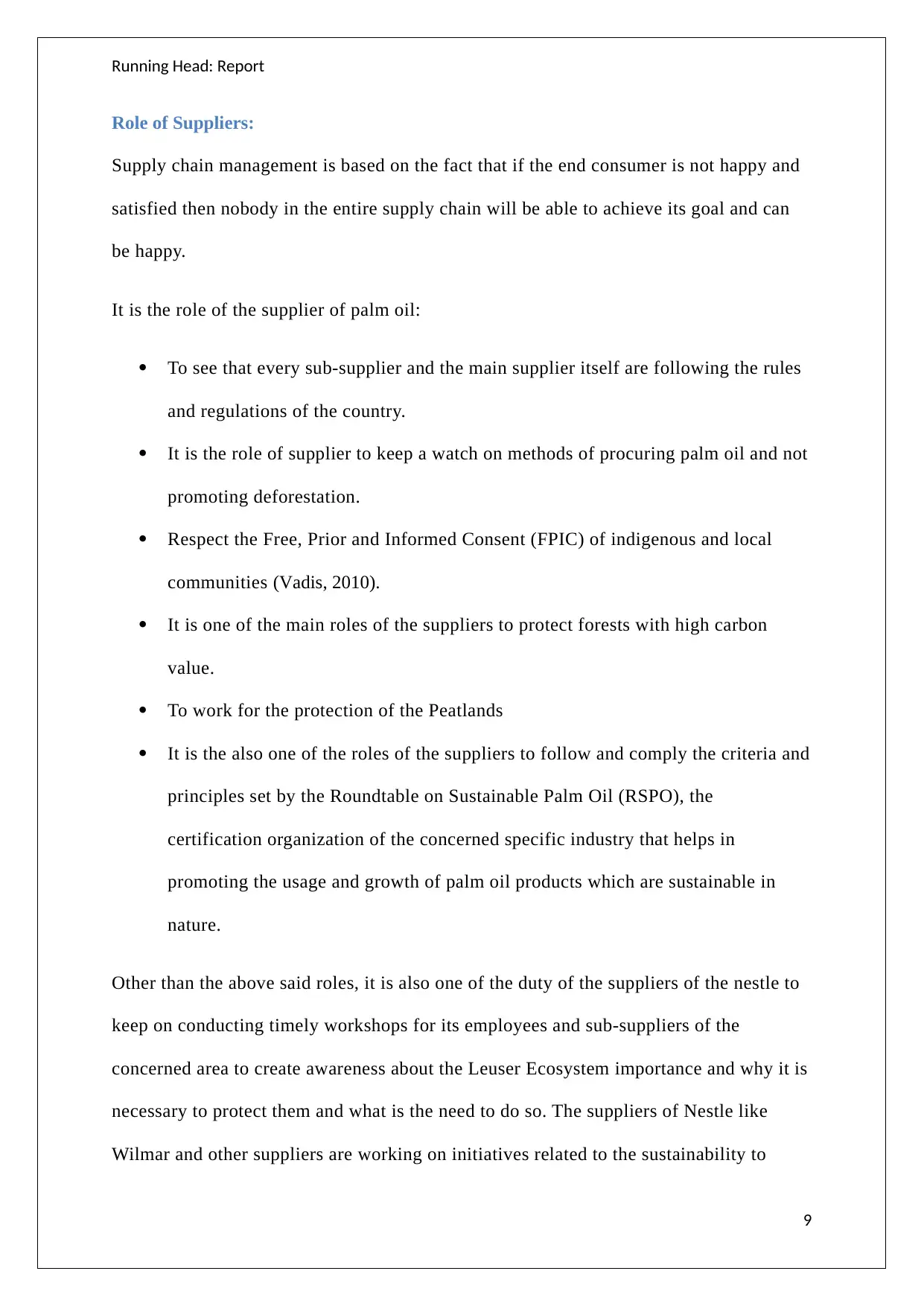
Running Head: Report
Role of Suppliers:
Supply chain management is based on the fact that if the end consumer is not happy and
satisfied then nobody in the entire supply chain will be able to achieve its goal and can
be happy.
It is the role of the supplier of palm oil:
To see that every sub-supplier and the main supplier itself are following the rules
and regulations of the country.
It is the role of supplier to keep a watch on methods of procuring palm oil and not
promoting deforestation.
Respect the Free, Prior and Informed Consent (FPIC) of indigenous and local
communities (Vadis, 2010).
It is one of the main roles of the suppliers to protect forests with high carbon
value.
To work for the protection of the Peatlands
It is the also one of the roles of the suppliers to follow and comply the criteria and
principles set by the Roundtable on Sustainable Palm Oil (RSPO), the
certification organization of the concerned specific industry that helps in
promoting the usage and growth of palm oil products which are sustainable in
nature.
Other than the above said roles, it is also one of the duty of the suppliers of the nestle to
keep on conducting timely workshops for its employees and sub-suppliers of the
concerned area to create awareness about the Leuser Ecosystem importance and why it is
necessary to protect them and what is the need to do so. The suppliers of Nestle like
Wilmar and other suppliers are working on initiatives related to the sustainability to
9
Role of Suppliers:
Supply chain management is based on the fact that if the end consumer is not happy and
satisfied then nobody in the entire supply chain will be able to achieve its goal and can
be happy.
It is the role of the supplier of palm oil:
To see that every sub-supplier and the main supplier itself are following the rules
and regulations of the country.
It is the role of supplier to keep a watch on methods of procuring palm oil and not
promoting deforestation.
Respect the Free, Prior and Informed Consent (FPIC) of indigenous and local
communities (Vadis, 2010).
It is one of the main roles of the suppliers to protect forests with high carbon
value.
To work for the protection of the Peatlands
It is the also one of the roles of the suppliers to follow and comply the criteria and
principles set by the Roundtable on Sustainable Palm Oil (RSPO), the
certification organization of the concerned specific industry that helps in
promoting the usage and growth of palm oil products which are sustainable in
nature.
Other than the above said roles, it is also one of the duty of the suppliers of the nestle to
keep on conducting timely workshops for its employees and sub-suppliers of the
concerned area to create awareness about the Leuser Ecosystem importance and why it is
necessary to protect them and what is the need to do so. The suppliers of Nestle like
Wilmar and other suppliers are working on initiatives related to the sustainability to
9
Paraphrase This Document
Need a fresh take? Get an instant paraphrase of this document with our AI Paraphraser

Running Head: Report
address Deforestation kind of problems and issues. It will ultimately help Nestle in
knowing the areas where deforestation is at extreme and which supplier is extracting
palm oil from there so that strong actions can be taken towards them (Kokemuller, 2017).
Performance of Nestle Palm Oil Suppliers:
Every palm oil supplier of Nestle is required to meet the requirements laid down by the
RSG. Nestle supports those suppliers who are unable to meet the requirements of RSG in
the current timeline but are ready and willing to match it and can do commendable
progress by working in that direction, by helping them to make such transformation
relevant for both of them. In the year 2012, Nestle started working with the TFT which
helped the company in developing an approach which was totally new and focussed
clearly on the transparency. Nestle and its suppliers use this knowledge and transparency
in the supply of palm oil.
Since the year 2010, when the system of palm oil traceability was established, the
suppliers, who are involved in sourcing 85% of the company’s palm oil, engage directly
with the Nestle. 40% of Nestle’s palm oil volume can be traced back to the mills from
where it was produced an outsourced and the country to which it belongs. The volume of
palm oil is sourced responsibly and it accounts for almost 14% of the volume, i.e. the
plantation of its origin can be traced, it can be accessed under RSG, continuous
improvement can be done. Nestle’s 5% of the volume is compliant, fully, which means
that it can be traced to a particular level of the plantation and can be seen that it is in
accordance with the requirements of the guidelines set up by the RSG. 100% of Nestle’s
palm oil were certified by the RSPO in the year 2013 which included 15%segregation by
the RSPO and an estimated 85% in the form of certificates of GreenPalm (Butler, 2010).
10
address Deforestation kind of problems and issues. It will ultimately help Nestle in
knowing the areas where deforestation is at extreme and which supplier is extracting
palm oil from there so that strong actions can be taken towards them (Kokemuller, 2017).
Performance of Nestle Palm Oil Suppliers:
Every palm oil supplier of Nestle is required to meet the requirements laid down by the
RSG. Nestle supports those suppliers who are unable to meet the requirements of RSG in
the current timeline but are ready and willing to match it and can do commendable
progress by working in that direction, by helping them to make such transformation
relevant for both of them. In the year 2012, Nestle started working with the TFT which
helped the company in developing an approach which was totally new and focussed
clearly on the transparency. Nestle and its suppliers use this knowledge and transparency
in the supply of palm oil.
Since the year 2010, when the system of palm oil traceability was established, the
suppliers, who are involved in sourcing 85% of the company’s palm oil, engage directly
with the Nestle. 40% of Nestle’s palm oil volume can be traced back to the mills from
where it was produced an outsourced and the country to which it belongs. The volume of
palm oil is sourced responsibly and it accounts for almost 14% of the volume, i.e. the
plantation of its origin can be traced, it can be accessed under RSG, continuous
improvement can be done. Nestle’s 5% of the volume is compliant, fully, which means
that it can be traced to a particular level of the plantation and can be seen that it is in
accordance with the requirements of the guidelines set up by the RSG. 100% of Nestle’s
palm oil were certified by the RSPO in the year 2013 which included 15%segregation by
the RSPO and an estimated 85% in the form of certificates of GreenPalm (Butler, 2010).
10
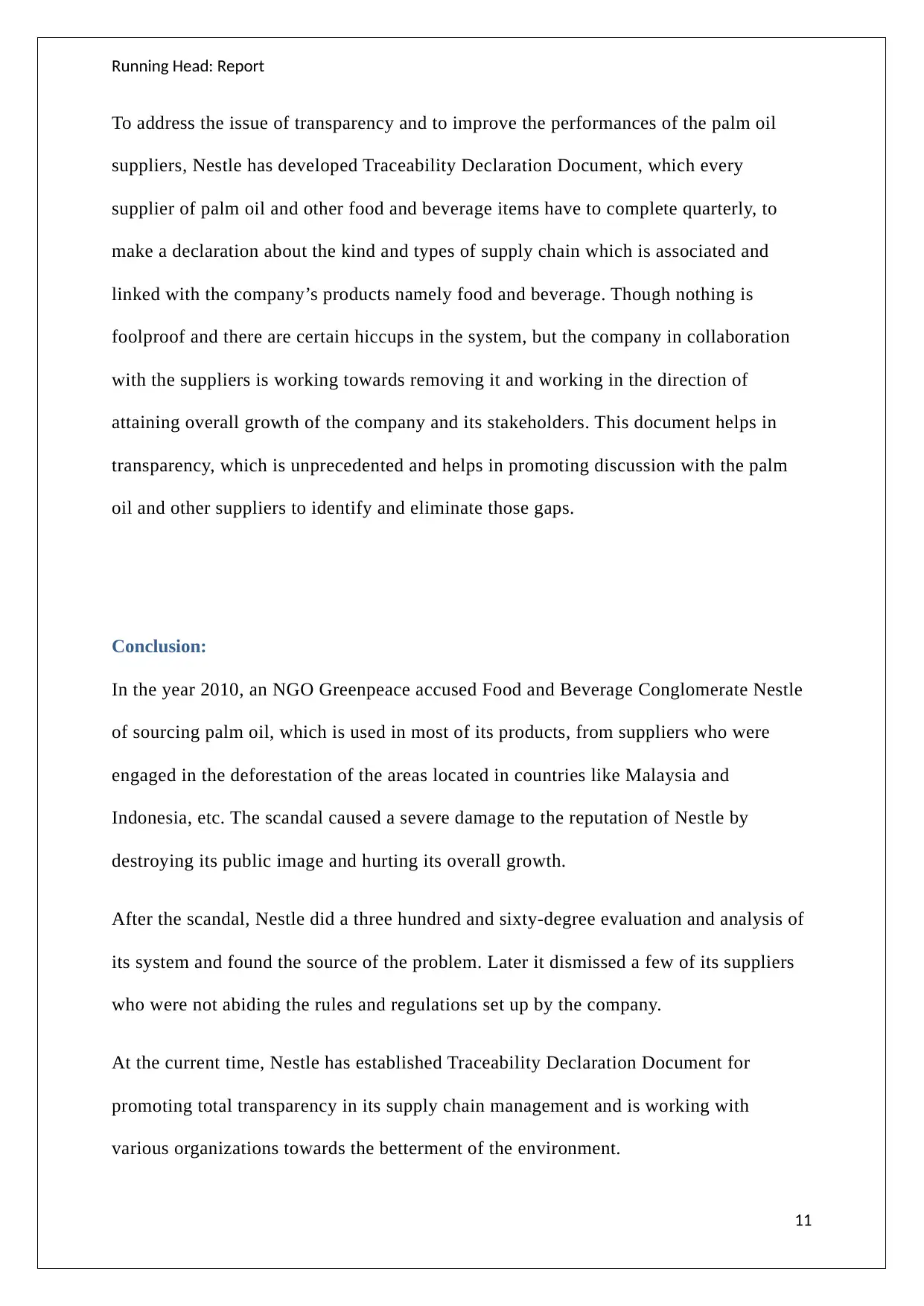
Running Head: Report
To address the issue of transparency and to improve the performances of the palm oil
suppliers, Nestle has developed Traceability Declaration Document, which every
supplier of palm oil and other food and beverage items have to complete quarterly, to
make a declaration about the kind and types of supply chain which is associated and
linked with the company’s products namely food and beverage. Though nothing is
foolproof and there are certain hiccups in the system, but the company in collaboration
with the suppliers is working towards removing it and working in the direction of
attaining overall growth of the company and its stakeholders. This document helps in
transparency, which is unprecedented and helps in promoting discussion with the palm
oil and other suppliers to identify and eliminate those gaps.
Conclusion:
In the year 2010, an NGO Greenpeace accused Food and Beverage Conglomerate Nestle
of sourcing palm oil, which is used in most of its products, from suppliers who were
engaged in the deforestation of the areas located in countries like Malaysia and
Indonesia, etc. The scandal caused a severe damage to the reputation of Nestle by
destroying its public image and hurting its overall growth.
After the scandal, Nestle did a three hundred and sixty-degree evaluation and analysis of
its system and found the source of the problem. Later it dismissed a few of its suppliers
who were not abiding the rules and regulations set up by the company.
At the current time, Nestle has established Traceability Declaration Document for
promoting total transparency in its supply chain management and is working with
various organizations towards the betterment of the environment.
11
To address the issue of transparency and to improve the performances of the palm oil
suppliers, Nestle has developed Traceability Declaration Document, which every
supplier of palm oil and other food and beverage items have to complete quarterly, to
make a declaration about the kind and types of supply chain which is associated and
linked with the company’s products namely food and beverage. Though nothing is
foolproof and there are certain hiccups in the system, but the company in collaboration
with the suppliers is working towards removing it and working in the direction of
attaining overall growth of the company and its stakeholders. This document helps in
transparency, which is unprecedented and helps in promoting discussion with the palm
oil and other suppliers to identify and eliminate those gaps.
Conclusion:
In the year 2010, an NGO Greenpeace accused Food and Beverage Conglomerate Nestle
of sourcing palm oil, which is used in most of its products, from suppliers who were
engaged in the deforestation of the areas located in countries like Malaysia and
Indonesia, etc. The scandal caused a severe damage to the reputation of Nestle by
destroying its public image and hurting its overall growth.
After the scandal, Nestle did a three hundred and sixty-degree evaluation and analysis of
its system and found the source of the problem. Later it dismissed a few of its suppliers
who were not abiding the rules and regulations set up by the company.
At the current time, Nestle has established Traceability Declaration Document for
promoting total transparency in its supply chain management and is working with
various organizations towards the betterment of the environment.
11
⊘ This is a preview!⊘
Do you want full access?
Subscribe today to unlock all pages.

Trusted by 1+ million students worldwide
1 out of 16
Related Documents
Your All-in-One AI-Powered Toolkit for Academic Success.
+13062052269
info@desklib.com
Available 24*7 on WhatsApp / Email
![[object Object]](/_next/static/media/star-bottom.7253800d.svg)
Unlock your academic potential
Copyright © 2020–2025 A2Z Services. All Rights Reserved. Developed and managed by ZUCOL.





